Vinegar Syndrome summer binge, part two
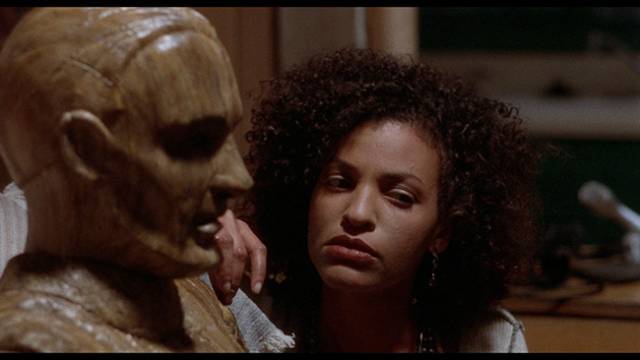
The Fear (Vincent Robert, 1995)
Vincent Robert was a one-time director and with a better script The Fear (1995) might’ve been a more memorable movie. There are some genuinely creepy elements, but it never really gels. The first surprise is finding Wes Craven in a cameo at the beginning as a college psychology prof who urges student Richard (Eddie Bowz) to pursue his research into the nature of fear by taking a bunch of fellow students to a remote cabin in the woods for a weekend of … well, that’s not entirely clear. Delving into their deepest fears in some kind of group therapy. They’re your typical mix of sexy, bitchy, horny students. They’re also gathered in the shadow of a recent series of campus rapes, with the possibility that one of them may be the rapist.
Once they get to the cabin, which belongs to Richard’s folks and where he spent a lot of time as a kid, they find a creepy life-size wooden statue named Morty which was Richard’s childhood companion. Propped up in the living room, Morty quickly becomes the figure everyone confesses their fears to. And as bad things begin to happen, he also seems to come to menacing life. Unfortunately, what’s going on remains too vague to generate the suspense we’ve been promised. The claustrophobic core is diffused by the introduction of a nearby creepy closed Santa village run by Richard’s creepy uncle Pete (Vince Edwards), who’s partial to much younger women. The initial idea that everyone’s personal fear is going to manifest in fatal ways never really develops, but Morty remains an interesting if underused element of horror.
The 4K transfer is fine and there are two commentaries, with director Robert and executive producer Greg H. Sims, plus a 50-minute making-of.
*
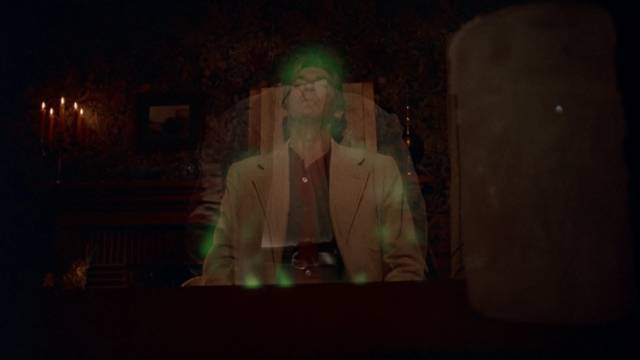
Grave Secrets (Donald P. Borchers, 1989)
Like The Fear, Donald P. Borchers’ Grave Secrets (1989) is a generic horror movie with some effective moments which is let down by a weak script and uneven direction. A haunted house story mixed with some psychological horror, it ends up seeming unaware of the real horror at its centre as it works hard to pull off familiar, superficial scares. It doesn’t help that it has a weak lead performance from Paul Le Mat as a professor of parapsychology who appears to be an embarrassment to his school. David Shaw has just been turned down yet again for funding of his research into survival after death when he’s approached by a nervous woman who claims her bed-and-breakfast is haunted by a troublesome ghost which she’d like him to get rid of. There’s something she’s not telling him and when he drives out to the place, she’s changed her mind and wants him to leave right away.
But he refuses to go (it’s late and he needs a place to stay for the night). An unwelcome guest, he witnesses some manifestations, including eggs that lift themselves from the fridge and throw themselves at him. Despite her increasing hostility, he hangs around and even invites a mediumistic friend to stop by for a seance. The resident spirit turns out to be really malevolent and the medium ends up being carried off by ambulance after being attacked. And so it goes, with a perfunctory and completely failed attempt to suggest a possibility of romance between Shaw and the woman, before the final reveal of the ghost’s identity and horrific backstory. Spoiler alert, this involves incest, rape, infanticide and murder, all of which is far grimmer and darker than the mediocre ghost activity which preceded the revelation, yet is given no more weight by Borchers’ direction.
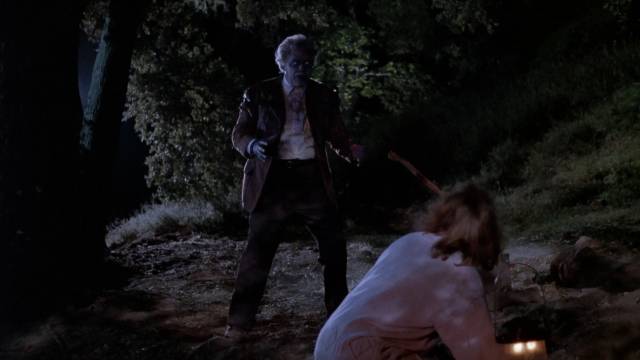
Le Mat gives a dull performance completely devoid of charm and there’s absolutely no chemistry between him and Renée Soutendijk. She, the chilly seductress from Paul Verhoeven’s The Fourth Man (1983), works really hard with an ill-defined role which depends too much on her concealing key information about the story. David Warner does his best with his brief turn as the medium, but the character is little more than a time-filler, while punk rocker and occasional actor Lee Ving hangs around as a vaguely threatening red herring.
Grave Secrets is one of those movies which annoys because it can’t quite manage to pull together the basic generic elements that might satisfy an undemanding viewer. The 2K transfer looks fine, though, and director Borchers talks about his career and putting the production together in a brief audio interview.
*
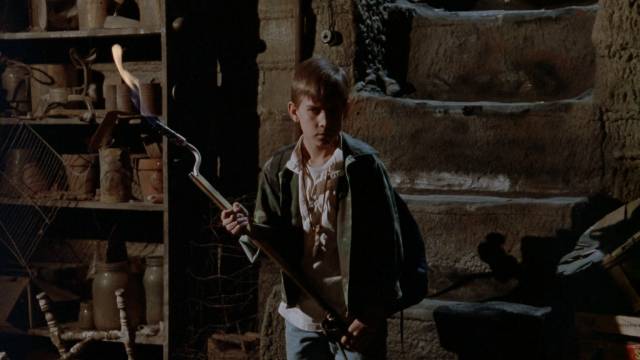
The Cellar (Kevin S. Tenney, 1989)
Kevin S. Tenney is someone who does know how to pull those generic elements together and provide a satisfying hour-and-a-half of entertaining atmosphere and scares. This is as true of The Cellar (1989), his fourth feature, as it was of his first, Witchboard (1986), even though the former was a salvage job for which Tenney was hired when the original director ran into problems and he had little time to prepare. It’s based on a very short creepy story which I remember reading decades ago and which came back to me towards the end of the movie. Necessarily, the adaptation has to build a lot more business around the single, simple idea of the story, and that includes some family conflict and a bit of Native mumbo-jumbo about an ancient curse on the land where the Cashen family have come to live.
There’s dad Mance (Patrick Kilpatrick), stepmom Emily (Suzanne Savoy) and young son Willy (Chris Miller). There’s a crazy old man in the neighbourhood (Ford Rainey), who mutters warnings – in the prologue, when he was about Willy’s age he saw the monster lurking beneath the land – and a local Native American named Chief Sam John (Michael Wren) is always around, trying to maintain a bunch of protective objects which keep the menace at bay. As his parents deal with financial and relationship issues, Willy becomes aware of the creature which had been conjured up to protect the land from interlopers, but mom and dad don’t take him seriously when he begins to talk of his fears.
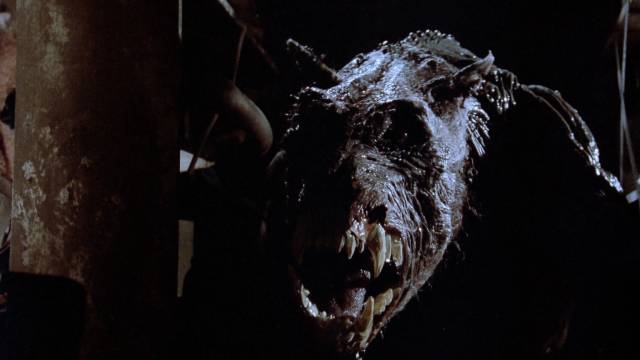
Things escalate when the local bully gets pulled into a sinkhole by the monster; the sheriff assumes the kid ran away and no one believes what Willy saw. Things get worse, but dad loses his patience with Willy’s wild tales and eventually locks him in the basement where he’s finally attacked by the monster. Essentially kids’ horror along the lines of Disney’s The Watcher in the Woods (John Hough, 1980) and Tibor Takacs’ The Gate (1987), The Cellar may not be ambitious, but it is atmospheric and the monster, when it shows up, is a suitably effective prosthetic suit with nasty claws and teeth. It’s the kind of movie best appreciated by your adolescent self and on those terms it works quite nicely.
The movie’s troubled history doesn’t end with original director John Woodward (who also wrote the script) being replaced at the start of production and Tenney taking over with no prep time; once Tenney delivered his cut, the producers took it away and completely re-cut it for its original theatrical release. That did nothing to help the movie’s reputation and Vinegar Syndrome have gone all out by presenting Tenney’s previously unseen original cut in an attractive 2K transfer, along with the producers’ cut. The former is a decent little monster movie; the latter a mess better forgotten now that the director’s version is available. Though not a previously lost masterpiece, Tenney’s The Cellar is an enjoyable little entertainment.
The production problems are covered extensively in two commentary tracks with Tenney and leads Kilpatrick and Savoy, as well as a 46-minute making-of in which the participants talk frankly about what turned out to be an unhappy experience. It’s one of those cases that makes one wonder why producers don’t trust the directors they hire and end up ruining something which might otherwise have found an appreciative audience.
*
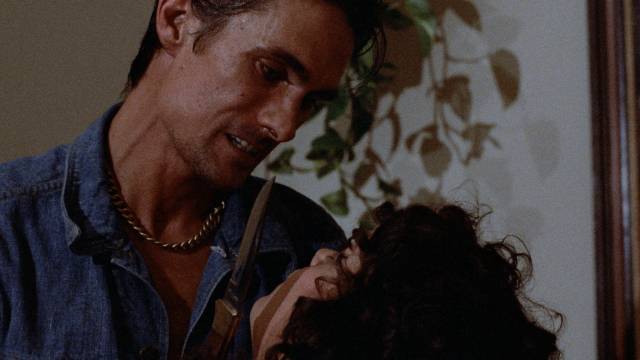
Alley Cat (Victor Ordonez et al., 1984)
Of course, vigilantism is unacceptable in the real world, but as a narrative device in fiction it appeals strongly to atavistic tendencies most of us share to one degree or another. As a genre, its tropes are well-defined – ordinary people are preyed on by vicious criminals; the authorities are more concerned with tamping down direct responses by the victims than with stopping the bad guys, because crime is part of the natural social order but taking the law into your own hands threatens the status quo; and one or more determined individuals finally step outside the rules to put an end to a bad situation. An added frisson is provided when the vigilante is a tough woman who has the ability to kick bad guy ass. In higher-end movies, all of this is dressed up with tut-tutting moral concern about the dangers of lowering yourself to the level of the predators. In the more exploitative version, audience frustration is played for maximum visceral satisfaction.
Alley Cat (1984) is neither the best nor worst example of the genre, but it doesn’t always hit that action sweet spot. Billie (Karen Mani) is a karate expert who lives with her grandparents. One night she sees a couple of punks trying to strip her car in the driveway and goes out to stop them; when they don’t simply leave, she beats them up and they go whining to their criminal boss Scarface (Michael Wayne). Later they beat up her grandparents and stab her grandmother to death. The cops aren’t very helpful, though a rookie named Johnny (Robert Torti) is sympathetic and the pair start a relationship.
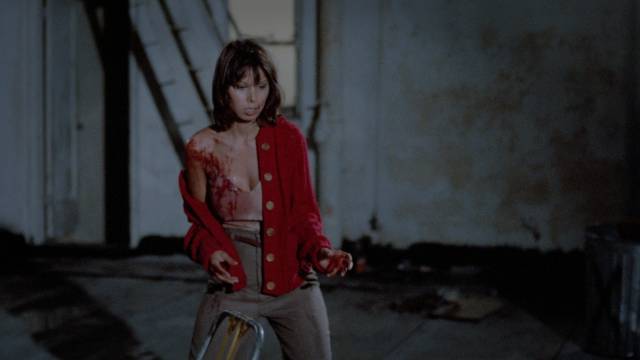
Despite the obvious danger, she maintains her practice of late-night running in the empty streets and parks of the neighbourhood, but her grandfather insists that she take his gun for protection. Coming across the same two punks trying to rape a hooker, Billie steps in and during the fight fires the gun. Although Johnny arrives on the scene, he’s accompanied by a corrupt cop who decides it’s Billie who needs to be arrested because she’s carrying an unlicensed, concealed weapon. A judge agrees and, despite having prevented a rape, Billie is sent to prison. Cue a brief women-in-prison sequence complete with group shower and tough lesbian cell-mate.
Once she’s released, Billie is in no mood to abide by the rules and sets out to put an end to Scarface and his gang. If Alley Cat seems ragged and unevenly paced, only hitting the genre notes intermittently, that’s no doubt because it began as a low-budget Filipino action movie shot on location in Los Angeles, ran into production difficulties, was taken over by another company and ended up with no less than three credited directors – Ed Palmos, who had a thirty-five year career, and Victor M. Ordonez and Al Valletta, for both of whom this is the sole directing credit. Although Mani displays decent fighting skills, she has very limited range as an actor (this appears to be her sole lead role), and none of the directors seem particularly adept at shooting action for maximum impact, so despite all the requisite elements being in place it feels rather flat.
Despite its minor status, Vinegar Syndrome have given it a 4K scan from the original negative and it looks pretty good for a ragged low-budget product of the early ’80s. There are two interview featurettes included, one with co-director Valletta, the other with co-star Torti.
*
The Cardona Collection (Rene Cardona Jr., 1978-84)
Vinegar Syndrome have launched yet another line of box sets with this three-disk collection of features from prolific Mexican director Rene Cardona Jr. With a lot to choose from (he has a hundred directing credits on IMDb), they’ve started with three titles from the middle of his forty-year career. This was when Cardona was branching out into international productions (as far as I can tell), with some big American and European names heading his casts, and stories showing the influence of the ’70s disaster genre. Although Cardona’s pacing in these movies is often sluggish, they tend towards a grimly serious tone rather than cheesy exploitation.
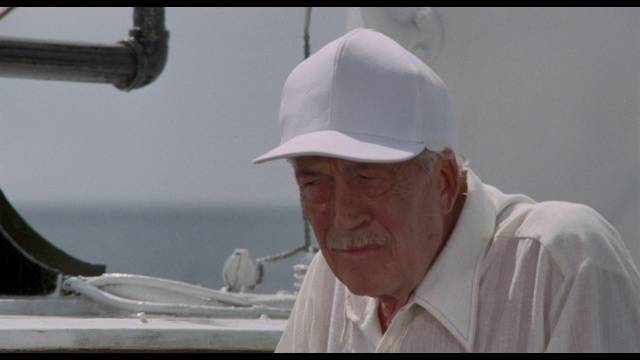
The Bermuda Triangle (1978)
In The Bermuda Triangle (1978), wealthy John Huston, his family and guests, head into the titular zone in search of a sunken city which may have been part of Atlantis. But before we get to his yacht, there’s a prologue in which we see a young girl desperately clinging to the deck of a 19th Century sailing ship during a storm and then an abrupt cut to the disappearance of Navy Flight 19 in December 1945, which leads to a quick sketch about other mysterious disappearances in the triangle. So we’re not surprised when there are hints of strange happenings. These are triggered when Huston’s young daughter spots an antique doll floating near the yacht; brought aboard, the creepy doll seems to possess the girl without anyone noticing and as people begin to die the doll gradually comes to life. We learn at the end, when a ship intercepts an SOS, that the yacht disappeared years ago. There are some atmospheric moments, some unpleasant animal violence (at least three sharks are killed on-screen), and some nice visuals – an underwater earthquake with a group of divers caught among collapsing ancient columns is well-staged – and some typical, perfunctory disaster film melodrama.
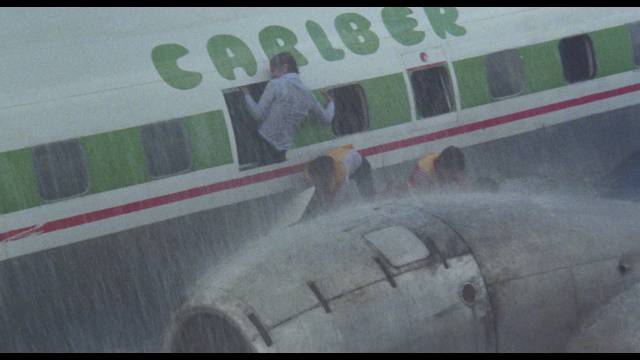
Cyclone (1978)
In Cyclone (1978), Cardona Jr. revisits some themes from Survive! (1976), the movie about the Uruguayan rugby team who crashed into the Andes and survived by cannibalism (IMDb attributes it to his father Rene Cardona, but Wikipedia credits Cardona Jr.; this confusion seems quite common among reviewers, so I don’t know for sure who was responsible!). Somewhere in the Caribbean, an island is hit by a powerful hurricane and three separate groups of survivors – crew and passengers on an airliner, crew of a trawler and the crew and passengers of a tourist boat – end up adrift together in the latter small craft with very little food and water. With all of them lost in the storm and now far from shipping lanes, it’s unlikely they’ll be found by searchers. It doesn’t take long for things to get grim – annoying wealthy woman Carroll Baker insists that her yappy little dog should get a share of the dwindling water supply; one of the trawler’s crew resolves that issue by butchering the dog and the rest of the survivors reluctantly chow down on the scraps of meat. As the days pass and people fade from hunger and thirst, it’s clear where we’re heading. Chunks are cut from the first man to die and used as fishing bait; but the next to go is filleted, with strips of flesh spread on the canopy to dry in the sun. Only priest Arthur Kennedy maintains a moral objection to eating the dead. And despite their shared “communion” the passengers end up fighting among themselves and causing the boat to sink. The grim finale has many of them being picked off by sharks just as a couple of planes fly over and spot them.
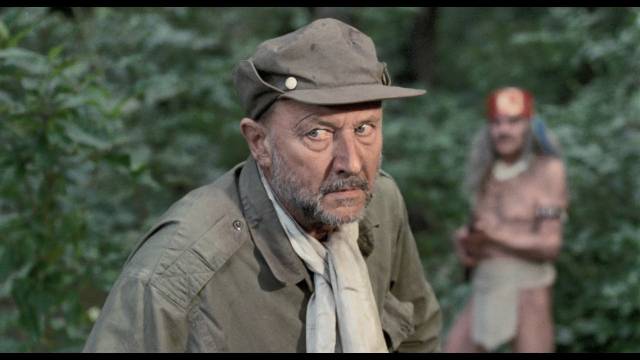
Treasure of the Amazon (1985)
In Treasure of the Amazon (1985), open water gives way to dense rain forest and three different groups heading off in search of gold and diamonds in a remote area populated by head-hunters with blow guns and poison darts, not to mention giant anacondas and big cats. Despite the natural dangers, its the rivalries among the greedy Europeans and Americans that prove fatal. There’s slightly crazy Stuart Whitman, Nazi Donald Pleasence, American pilot Bradford Dillman, and priest John Ireland, all threatened by local warlord Emilio Fernandez (Mapache from The Wild Bunch) who insists on his cut of any loot. Very few get out alive, but the scenery is spectacular.
Looking at Cardona Jr.’s list of credits, it appears that he returned to strictly Mexican productions after this period, so it will be interesting to see what direction subsequent volumes from Vinegar Syndrome take. Despite some tasteless animal violence (though generally not as extreme as Italian cannibal films from around the same time) and sluggish pacing, there are some impressive moments in all three films – that underwater earthquake in The Bermuda Triangle, the plane crash in Cyclone, the river scenery in Treasure of the Amazon – and some enjoyable performances in all of them. Cyclone was shot simultaneously in English and Spanish and apparently the versions are quite different, but so far I’ve only watched the English cut. Supplements include interviews with Rene Cardona III, who acts in both Triangle and Cyclone, producer of Triangle and Cyclone Angelo Iacono, and actor Carroll Baker.
*
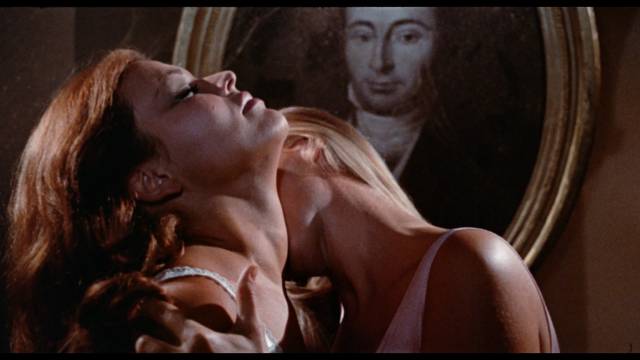
Count Dracula’s Great Love (Javier Aguirre, 1973)
Among the many gaps in my viewing experience, Spanish horror icon Paul Naschy looms large. I’ve been aware of him pretty much since I started reading about movies in my teens, but for a long time his movies weren’t accessible. As a prolific actor and slightly less prolific writer and director, he was pretty much the Spanish horror industry during the final decade of the Franco regime and continued on in post-Franco Spain until he died in 2009 at age 75. Maybe it’s just the sheer volume of his work that has put me off taking the plunge, though I did buy a copy of the BCI Eclipse DVD of Carlos Aured’s Horror Rises from the Tomb (1973) back in 2007, which I didn’t particularly like (and traded in long ago).
Count Dracula’s Great Love (1973), made immediately before that movie, is reputed to be one of Naschy’s best. Like Tomb, it’s a bit of a narrative mess, but it does benefit from some nice locations and an authentic Gothic atmosphere. The story, such as it is, has a man travelling with four women in a mid-19th Century coach. When they lose a wheel and the coachman is killed by a horse kick to the head, they walk to a nearby castle which was once an asylum where the inmates all died from a mysterious anemia. Locals attributed this to the fact that the head of the asylum was Dracula, who subsequently disappeared.
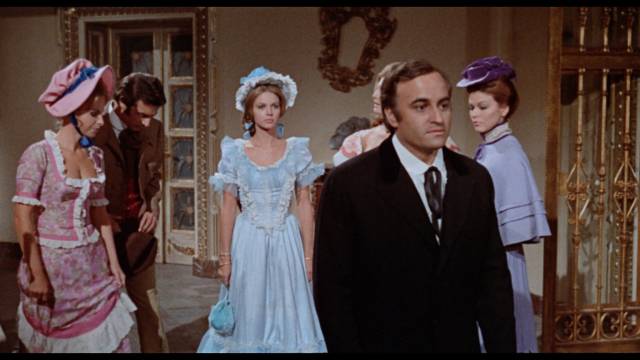
The wanderers are greeted by Dr. Marlow (Naschy) who is apparently planning to re-open the asylum. It doesn’t take long to discover that he’s Dracula himself. He works surprisingly quickly to put the bite on his guests and turn them into vampires, though there’s one in particular he’s attracted to and he needs her to give herself to him voluntarily to forge an eternal romance … or something. There’s also a loose subplot about restoring his skeletal daughter to vampiric life. More a series of incidents than an actual plot with narrative momentum, the movie spends a lot of time lingering on the actresses’ bare breasts, which calls to mind that it was more or less contemporary with Hammer’s Karnstein trilogy (1970-71) and Countess Dracula (1971).
My biggest problem with Count Dracula’s Great Love, though, is Naschy himself, who just seems like a very dull presence to me. I know his fans consider him one of the horror greats, but I couldn’t get interested in his supposed romantic torment. The transfer is fine and there’s a commentary from Naschy and director Javier Aguirre, which I haven’t listened to, and a brief interview with actress Mirta Miller.
Comments